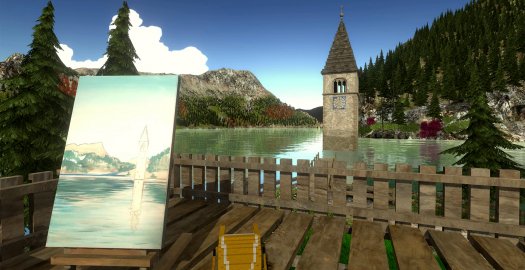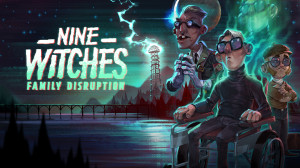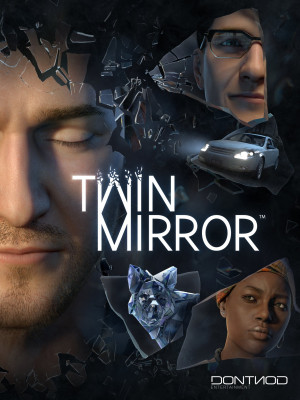Review for A Painter’s Tale: Curon, 1950

While many of us can only dream of visiting scenic Italy in person, now more than ever, there’s nothing stopping us from doing so virtually. A Painter’s Tale: Curon, 1950 is a historical fiction adventure game made with support from IVIPRO, the Italian Videogame Program used to facilitate the development of games based around the culture and geography of Italy. There are several services they provide, including a database of Italian History and Culture, and a catalogue of places and stories to feature in games. Indie developer Monkeys Tales Studio took advantage of this program to take players on a thoughtful time travel adventure to a quaint Italian municipality on the precipice of destruction, though the execution lacks the consistent visual presentation and equally interesting gameplay its compelling story deserves.
Curon was once a village near the border of Austria, but soon after World War II it was flooded to accommodate a hydroelectric dam being constructed nearby. Though a new town with the same name was eventually built on higher ground, A Painter’s Tale takes the original location, and its tragic story, and adds its own sentimental flair. In the game you play as a present-day painter named Tommaso, who is here to capture the last visible remnant of the submerged town above the water: the church steeple. However, he finds himself suddenly dragged into the lake when he goes to investigate a strange glow, and wakes up in the original Curon.
Our hero-out-of-time ends up in the care of Ida, a kindly woman who gives him her husband's clothes to wear and sends him on some small errands. This first act allows you to walk (or run) around a somewhat limited area of Curon and get to know its inhabitants. You, the player, are likely to be aware that you are in the year 1950, but for Tommaso it takes a bafflingly long amount of time to figure it out. Just as he finally becomes aware of his predicament, the bureaucratic wheels are set in motion, and the townspeople are notified of the plans to flood their homes for the sake of hydroelectric energy.
The story doesn’t so much focus on an attempt to save the town, but rather emphasising just how much injustice is being inflicted upon the people of Curon. Due to its location and the political situation at the time, the local population is predominantly German-speaking, which contributes to their unfavourable treatment under the Italian government. Tommaso struggles with his own motivations, as he wishes to return to his own time but feels he owes something to the people that have taken him in. This guilt is further exacerbated when all he can do is watch as the town sullenly prepares to be forced out of their homes. He eventually finds a purpose when he discovers that a government official plans to steal the bell from the church tower. Even if it doesn’t do much to aid the people of Curon, attempting to prevent this scheme from coming to fruition does let you feel like you are helping to at least symbolically preserve the town’s legacy.
A Painter’s Tale, as its title suggests, makes great use of art. You can examine various pieces that you find, and when doing so Tommaso will comment on it and even sometimes contemplate what it represents. The paintings you discover at times hint at past events or characters, and Tommaso even paints a couple of pieces of his own. Of course, not only does art act as a conduit for supplying backstory and emotional context, it’s lovely to look at in its own right, mainly consisting of realistic renditions of people or landscapes. Any piece of artwork you interact with will be stored in your notebook, just in case you wish to look at it again.
The notebook can be accessed any time, and it serves as a source of factual information about the real-life events of Curon (as opposed to the semi-fictional ones depicted in the game). Along with providing important historical context to help you better understand the events transpiring, at times it almost reads like a tourist information leaflet with tidbits about such things as local cuisine and old-fashioned kitchen appliances. Also, whenever you meet a new character, Tommaso will do a sketch of them that you can look at any time, which is a much-needed feature due to the underwhelming in-game character models.
When I first dove into A Painter’s Tale, I was not quite expecting to be running around as Minecraft Steve’s distant cousin. I have no problem with voxel graphics, but some of the game is voxel-based while the rest … isn’t. The character models are a bit better designed than in Minecraft, especially in terms of their shapes and how their limbs look a lot more natural; their walking animations are also surprisingly fluid and weighty. Compared to the more realistic-looking backgrounds, however, the detail and textures of the characters are severely lacking, and there is a distinct lack of facial expression during cutscenes and dialogue.
I was surprised to see how accurate the town design is compared to old photographs of the actual town I looked up online. Unfortunately, even the environments, such as houses, the church and the town square, are littered with voxel decorations, such as flowers, food, and furniture. These art styles really clash, especially in the way they seem to draw from completely different colour palettes. A shockingly saturated red flower made up of tiny blocks sure looks out of place on the same screen as a dreary, grey, realistically rendered wagon lying broken on a brown, muddy path. The discrepancy doesn’t seem to serve any kind of sign-posting purpose either, and ends up being distracting more than anything else.
In order to move around Curon, you will use WASD to walk (or run with Shift held) in third-person, pressing E to interact with and examine objects that appear as hotspots when you get close to them. I initially tried to play with a gamepad, but the controls were messy; even navigating menus was awkward and did not use the buttons I would have expected, so I gave up and went with the keyboard instead. Either way, any action you will take is contextual, depending on what is in front of you. This ended up being a pain, since almost every time I went to interact with something, Tommaso had to turn, take a couple of steps, and turn again so that he could be in the perfect position to go through with the interaction. This slowed the pace a little, and also broke immersion each time it happened.
The majority of the game consists mostly of talking to people and completing a few objectives – also recorded in the notebook – like fetching cheese from the inn, or sneaking into a government official’s hotel room. These are all heavily scripted and there are no puzzles to solve outside of a few mini-games sprinkled through the experience. One has you translate an Italian notice to German, essentially by filling spaces in sentences with the words you think will make sense, while another requires you to impress some drunk Italian officials at the inn by selecting the correct answers to their questions in order to get information from them. It may be possible to get these wrong, but they’re so easy it’s unlikely anyone will do so.
There are many characters to meet, such as the innkeeper and her taciturn husband, the church minister, and the hotel owner and his pianist daughter (all fictional people). You’ll get to know most of the available townsfolk throughout the game, which makes their predicament hit harder when you know their time here is running out. You will also come into contact with the odd Carabinieri (Italian police), though none of them are named or have unique personalities. Then there’s the dastardly g-man, bent on stealing the town’s bell and marrying the hotel owner’s daughter. The most significant relationship is between Tommaso and Ida, the kind woman who took him in whose painter husband is mysteriously absent. Dialogue sometimes gives you a choice of different replies, but it’s doubtful alternate responses have any significant effect on the way the story plays out, since there aren’t really any consequences that follow a particular choice. The writing is decent, for the most part, but there are some awkward lines that seem to be a result of an imperfect translation to English.
Even though there’s not much to do there, Curon really feels alive in A Painter’s Tale. When you first step out into the town square, it’s populated with children running around, gossiping old ladies, and farmers chatting to each other. This, coupled with the ambient sound design, would usually serve to create a blissful environment, but in this case it only serves to fuel the righteous indignation you feel for these people over the inevitable events to come. The soundtrack generally consists of piano pieces, with the occasional synth track added in, usually to evoke an eerie atmosphere. The main theme is exceedingly pleasant, but you can tell the developers are particularly proud of it as it is continually shoehorned in throughout.
The game runs smoothly, though when I initially played I lost about 25 minutes of progress when I quit, since at the time it autosaved only at the start of each of the game’s three acts. Fortunately, in response to early feedback, Monkey Tales very quickly added in more checkpoints, so you have to hand it to them for being responsive to player concerns.
A Painter’s Tale is a game where the “game” part takes a back seat and the story hogs all the attention. The presentation, with its conflicting art direction and blocky character models, does something of a disservice to the tale being told here. But I can still recommend it if you are looking for a nice and easy adventure game to experience for three or so hours. If nothing else, you’ll learn much more about a fascinating place in history, whose story is so compelling that a television series set there was recently released on Netflix. You could just read up on Curon, but the game uses its characters and their personal travails to push the sentimental idea that one’s sense of self can be intertwined with their material possessions and the place that they call home. This makes for an unforgettable tale about how a town, and an irreplaceable part of its inhabitants’ identities, were swept away one day back in 1950.




























